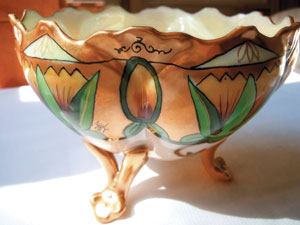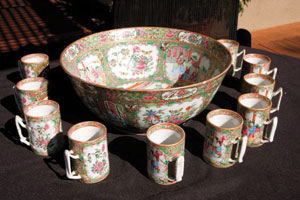 Anne sent me a photo of a highly decorated porcelain nut dish, signed “Wight.” Historically this came with at least four, possibly six, matching little nut dishes.
Anne sent me a photo of a highly decorated porcelain nut dish, signed “Wight.” Historically this came with at least four, possibly six, matching little nut dishes.
Nuts at each place at the table were a part of dinners until after World War II. The quaint custom that went the way of cucumber/pickle forks, aspic spoons, strawberry bowls, banana trays and announcement card salvers. Anne wrote that her mom either received this nut dish for her wedding in 1940 or inherited it from her own mother.
Anne’s mother, in fact, did inherit it from her mother. How do I know? Because Phillip Wight worked at Pickard China in Chicago in the first quarter of the 20th century, from 1905-1914.
Pickard China dates from 1893 in Wisconsin, and then moved to Chicago to take advantage of the young artists then practicing at the Chicago Art Institute. Pickard commissioned these artists to paint on porcelain. Presently, the company is owned by a fourth-generation family member, Andrew Pickard Morgan. The company received commissions to make official U.S. china for our embassies worldwide, as well as designs in china for Air Force One, Blair House and Camp David.
Anne’s piece is worth $200 in perfect condition.
Chinese Export Porcelain Punch Bowl

Donna sent me a photo of a Chinese export porcelain punch bowl and set of 10 mugs, matching, with double handles. The pattern, called Rose Medallion, comes with a long history dating from the 1840s, but Chinese porcelains’ export to Europe dates back to the 17th century. Why? Europe loved porcelain but lacked the formula to make it, and only the Chinese knew the secret.
In the early 17th century China sent wares to Portugal and England, primarily ordered by the wealthy, landed gentry, to boast on the plates their family crests. By the 19th century, the Chinese reimagined what patterns Europe purchased. They came up with Rose Medallion, which features distinctive pastel colors. The central motif is a peony or bird. From the center medallion radiates four or six panels of peonies, leaves, butterflies and sometimes cavorting robed Asian people.
Donna, if you find a mark underneath with “China,” the set is worth $200 to $300. That “China” insignia becomes the key. In 1890 Congress passed the McKinley Tariff Act to impose a tax on all foreign imports for the first time in the nation’s history. So to see “China” or “made in China” makes Donna’s set less valuable than the pre-tariff pieces. The older, the more valuable, in the case of Rose Medallion. Donna, the value if unmarked is $2,000. If more modern, it’s ten percent of that value.
Pingback: Mad Men Riviera Cocktail Set - Elizabeth Appraisals